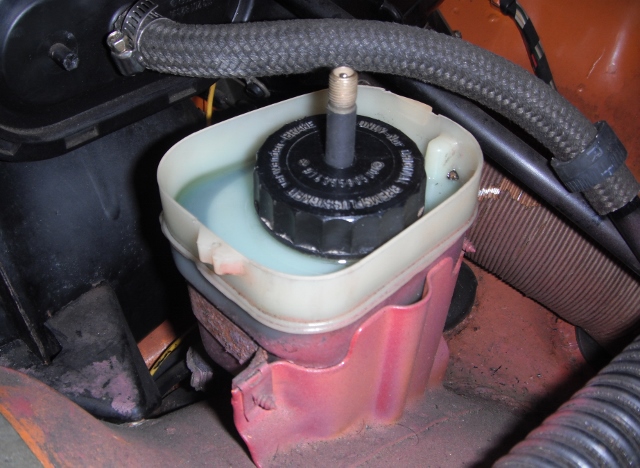|
|

|
Porsche, and the Porsche crest are registered trademarks of Dr. Ing. h.c. F. Porsche AG.
This site is not affiliated with Porsche in any way. Its only purpose is to provide an online forum for car enthusiasts. All other trademarks are property of their respective owners. |
|
|
  |
| IronHillRestorations |
 Sep 23 2014, 07:41 AM Sep 23 2014, 07:41 AM
Post
#21
|
|
I. I. R. C.      Group: Members Posts: 6,716 Joined: 18-March 03 From: West TN Member No.: 439 Region Association: None 
|
Pressure bleeding is the only way to go.
Here's what I posted back in Mar 05. Get a spare cap for the brake fluid reservoir. Get a tire valve & stem. Drill a hole in the center of the reservoir cap, the same size as the hole in a wheel (or measure the narrow part of the tire valve). Pull the valve stem through the hole. Remove the plastic screen in the reservoir. Fill the brake reservoir completely, not to the fill line, all the way full to the bottom of the tube that holds the plastic screen. Put on your new modified pressure bleeder cap. Drain your air tank to 10 psi, for cheaper compressors setting the regulator at 10 psi may not work. If you put too much pressure in the system, you'll blow off the blue lines that connect the supply lines to the reservoir, or worse. Take a clip on air chuck and clip it on your new pressure bleeder cap. Bleed the brakes, starting at the furthest bleeder from the master cyl, and finish at the bleeder nearest the master cyl. Bleeding sequence (LR-RR-LF-RF) Pump the pedal hard about ten times and repeat the procedure. Do not get brake fluid on painted surfaces it will ruin them. If the pressure bleeder cap retains pressure, bleed it down before taking it off the reservoir. This works very well, and makes it a one person job. Replace brake fluid every two years. Properly discard used brake fluid. |
| kkid |
 Sep 23 2014, 10:44 AM Sep 23 2014, 10:44 AM
Post
#22
|
|
Member   Group: Members Posts: 343 Joined: 18-December 07 From: Oakland, CA Member No.: 8,483 Region Association: Northern California |
Pressure bleeding is the only way to go. Here's what I posted back in Mar 05. Get a spare cap for the brake fluid reservoir. Get a tire valve & stem. Drill a hole in the center of the reservoir cap, the same size as the hole in a wheel (or measure the narrow part of the tire valve). Pull the valve stem through the hole. Remove the plastic screen in the reservoir. Fill the brake reservoir completely, not to the fill line, all the way full to the bottom of the tube that holds the plastic screen. Put on your new modified pressure bleeder cap. Drain your air tank to 10 psi, for cheaper compressors setting the regulator at 10 psi may not work. If you put too much pressure in the system, you'll blow off the blue lines that connect the supply lines to the reservoir, or worse. Take a clip on air chuck and clip it on your new pressure bleeder cap. Bleed the brakes, starting at the furthest bleeder from the master cyl, and finish at the bleeder nearest the master cyl. Bleeding sequence (LR-RR-LF-RF) Pump the pedal hard about ten times and repeat the procedure. Do not get brake fluid on painted surfaces it will ruin them. If the pressure bleeder cap retains pressure, bleed it down before taking it off the reservoir. This works very well, and makes it a one person job. Replace brake fluid every two years. Properly discard used brake fluid. My wife doesn't wanna have a right foot exercise in my car anymore so I do the same way as you do but with a bicycle air pump with a pressure gauge. Never blew my old blue hoses or marriage so far.... (IMG:style_emoticons/default/smile.gif)  |
| Downerman |
 Sep 23 2014, 11:12 AM Sep 23 2014, 11:12 AM
Post
#23
|
|
Member   Group: Members Posts: 168 Joined: 23-April 09 From: Monterey County, California Member No.: 10,296 Region Association: None |
Nice..... so what do you think the difference is between pressure and suction? I mean that as a legitimate question not a defiant one. As I said, I had no bubbles but solid break fluid doing the suction method but no pedal. Problem was, and please don't quote me because I don't know the actual names but apparently the "Chambers" inside the caliper had air that would have normally risen to the bleeder but because I was horizontal, well, it never happened.
I do like this idea though. Dave |
| Tbrown4x4 |
 Sep 28 2014, 10:54 AM Sep 28 2014, 10:54 AM
Post
#24
|
|
Senior Member    Group: Members Posts: 703 Joined: 13-May 14 From: Port Orchard, WA Member No.: 17,338 Region Association: None 
|
So....Any luck?
I'm also a fan of pressure bleeding, but not everyone has access to the equipment. I have what looks like a pump sprayer with a gauge and adapter I used at BMW. The adapter also fits some Volvos. On a side note, I was just helping my son bleed the clutch system on his Mazda truck. Fluid was coming out and the level in the reservoir was going down, but no pedal. I had him pull the clutch master and the corrosion in the bore was keeping the piston from returning all the way out. New master and it bled like a champ. |
  |
1 User(s) are reading this topic (1 Guests and 0 Anonymous Users)
0 Members:

|
Lo-Fi Version | Time is now: 5th May 2024 - 09:25 AM |
Invision Power Board
v9.1.4 © 2024 IPS, Inc.








